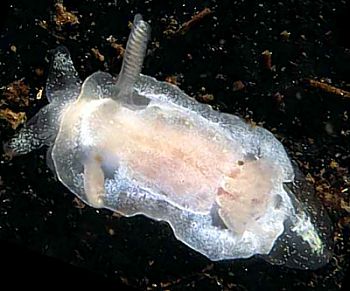
Goniodoris nodosa
(Montagu, 1808)
Order: NUDIBRANCHIA
Suborder: DORIDINA
Superfamily: ANADORIDOIDEA
Family: Goniodorididae
DISTRIBUTION
Northeastern Atlantic from Norway to northwest Spain, including British Isles.
PHOTO
Lephinchapel Reef, Loch Fyne on the west coast of Scotland, January 2000. 8 metres. Photo: Jim Anderson.
Grows to 27 mm in length. Body is translucent, with white speckling and bands and tinges of yellow and pink on the dorsum. Patches of transparent skin around the bases of the rhinophores and behind the gills, give the appearance of false 'pores'. A low keel runs down the middle of the back and on either side of this are small conical tubercles; a median keel is also visible on the dorsal surface of the metapodium or 'tail'. The oral tentacles are flattened and relatively large. Juveniles feed upon both ctenostome bryozoans, [such as Alcyonidium polyoum and Flustrellidra hispida], and cheilostome bryozoans such as Callopora dumerili, but adults feed on ascidians, such as Diplosoma listerianum, Botryllus schlosseri and Dendrodoa grossularia. Thompson (1988) notes that it is a common intertidal and shallow sublittoral species all around the British Isles, down to 20 m, although in southern Norway it has been reported down to 120 m.
Reference:
• Thompson, T.E. (1988) Molluscs: Benthic Opisthobranchs (Mollusca: Gastropoda). Synopses of the British Fauna (New Series). No. 8. 2nd Edition. E.J.Brill/W. Backhuys: Leiden. 1-356.
Rudman, W.B., 2001 (December 3) Goniodoris nodosa (Montagu, 1808). [In] Sea Slug Forum. Australian Museum, Sydney. Available from http://www.seaslugforum.net/find/goninodo
Related messages
Goniodoris nodosa from Mumbles, south Wales
August 12, 2008
From: Judith Oakley
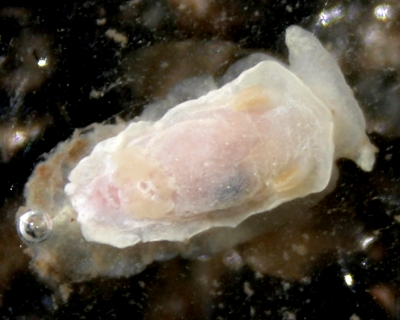
Hi Bill,
I found around 25 specimens of Goniodoris nodosa and spawn under Mumbles Pier, near Swansea, South Wales, UK on 6 April 2008. It was a very low spring tide of around 0.5 m.
Note; all of my records are intertidal.
Best wishes
Judith Oakley
jomoakley@btinternet.com
Oakley, J., 2008 (Aug 12) Goniodoris nodosa from Mumbles, south Wales. [Message in] Sea Slug Forum. Australian Museum, Sydney. Available from http://www.seaslugforum.net/find/21784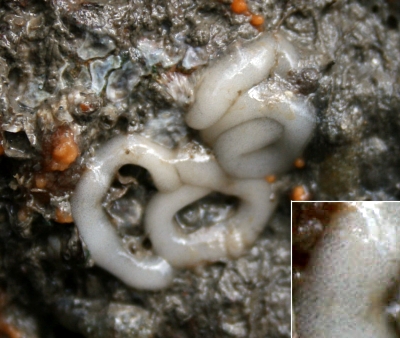
Thanks Judith,
Best wishes,
Bill Rudman
Goniodoris nodosa from Plymouth, England
August 8, 2006
From: Judith Oakley
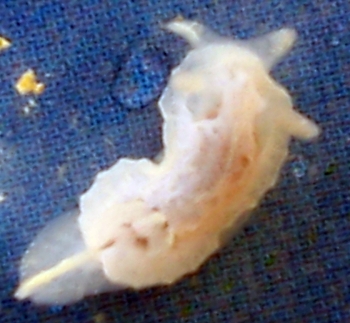
Please could you help me identify this white sea slug found on kelp on marina pontoon. Could it be Goniodoris nodosa as there was plenty of Diplosoma sp. around for it to feed on.
Locality: Queen Anne's Battery, Plymouth, UK, 01 August 2006, on Laminaria saccharina on marina pontoon. Length: 4 mm. Photographer: Judith Oakley.
Thanks
Judith Oakley
jomoakley@btinternet.com
Oakley, J.A., 2006 (Aug 8) Goniodoris nodosa from Plymouth, England. [Message in] Sea Slug Forum. Australian Museum, Sydney. Available from http://www.seaslugforum.net/find/17344
Dear Judith,
Even though it hasn't quite got its adult shape, the wide flattened oral tentacles and the milky yellow blotches and markings are typical of this species.
Best wishes,
Bill Rudman
Goniodoris nodosa from Scotland
December 7, 2001
From: Jim Anderson

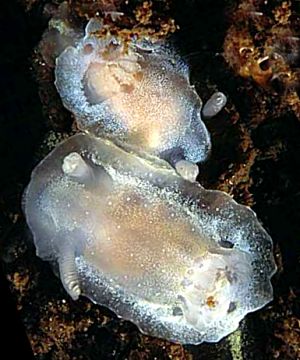
Dear Dr. Rudman,
Attached are a couple of images for the Forum.
UPPER: Lephinchapel Reef, Loch Fyne on the west coast of Scotland, January 2000. Several of these pretty little dorids were found crawling over the smooth rock face on the top surfaces of the reef at around 8 metres.
LOWER: South Gortein, Loch Fyne, again on the west coast of Scotland, January 2000. This 'mating?' pair were found at 12 metres on the smooth upper rock surface of the reef. This reef is approx 1500 metres south from the first.
Regards,
Jim A
jander4454'aol.com
Anderson, J., 2001 (Dec 7) Goniodoris nodosa from Scotland. [Message in] Sea Slug Forum. Australian Museum, Sydney. Available from http://www.seaslugforum.net/find/5749Thanks Jim,
Bill Rudman
